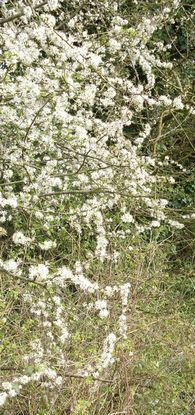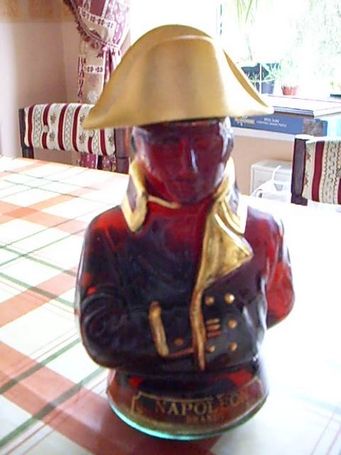Sloes
By Mike on Tuesday, November 20, 2007, 23:52 - Permalink
 I went out specifically looking for sloes - as opposed to than my usual trick of just accidentally tripping over something interesting and edible.
I went out specifically looking for sloes - as opposed to than my usual trick of just accidentally tripping over something interesting and edible.
What are sloes?
Sloes - also known as Blackthorn - are very small, bitter plums (although they are a distinct species: Prunus spinosa) that grow on spiny bushes in hedgerows and on heaths and wood edges.
The fruits are small - about 1cm in diameter - the skins are dark purple/black with a waxy bloom that makes them look bluish, greenish flesh and a single hard stone in the middle.
They are intensely bitter and astringent and are not generally eaten raw (except by my children, who eat them like sweets)
Sloes in flower
 Photographed in April - this is what Blackthorn bushes look like when they are in flower:
Photographed in April - this is what Blackthorn bushes look like when they are in flower:
They're really abundant this year(2007) - must be all that rain we had back in the summer.
We've had the first frosts now, so they've lost their bluish bloom and have started to soften and fall off the bushes - it's the perfect moment to be picking them. What to do with them
 Sloes are most commonly used to flavour liqueurs - sloe gin is probably the most famous of these and is made by pricking the fruits, then steeping them in gin, with sugar and spices added, for up to a year - during which time the flavour and colour of the sloes is drawn out into the liqueur to make a pleasant and quite potent alcoholic drink (it is, after all, still mostly gin).
Sloes are most commonly used to flavour liqueurs - sloe gin is probably the most famous of these and is made by pricking the fruits, then steeping them in gin, with sugar and spices added, for up to a year - during which time the flavour and colour of the sloes is drawn out into the liqueur to make a pleasant and quite potent alcoholic drink (it is, after all, still mostly gin).
Sloe gin does retain some of the astringency of the raw fruit, but not at an unpleasant level. The drink makes an excellent remedy for a tickly cough or sore throat and it's amazing how many people suddenly develop these ailments when they know you've got a bottle of the stuff hidden away somewhere.
 I'm not making sloe gin because I don't have any gin to hand, I'm using brandy instead. I pricked about half a pound of the sloes (they're really nice fat juicy ones this year) and pushed them into the neck of my bottle of brandy, then added a few tablespoons of brown sugar and a bit of cinnamon - that was a few days ago and I have been inverting the bottle every day to mix things up - the sugar is now all dissolved and the colour of the fruit is starting to show in the liquor.
I'm not making sloe gin because I don't have any gin to hand, I'm using brandy instead. I pricked about half a pound of the sloes (they're really nice fat juicy ones this year) and pushed them into the neck of my bottle of brandy, then added a few tablespoons of brown sugar and a bit of cinnamon - that was a few days ago and I have been inverting the bottle every day to mix things up - the sugar is now all dissolved and the colour of the fruit is starting to show in the liquor.
(the brandy I'm using for this project isn't the original stuff that came in this bottle, by the way)
It does take a great deal of patience and this is made worse by the fact that I didn't make any last year (it would be ready for tasting about now). Oh well - roll on NEXT Christmas.
